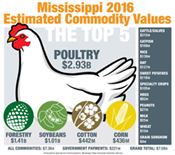|
Agriculture Value Is Part Of State's Economy

STARKVILLE, MISS.
The estimated $7.6 billion value of Mississippi agriculture increased by 1.8 percent in 2016, helping the industry retain its prominence in the state’s overall economy.
“Agriculture's reach in the state goes well beyond just the value of the goods produced,” said Brian Williams, an agricultural economist with the Mississippi State University Extension Service. “The ag industry helps support many of our small towns across the state, as producers purchase inputs at the local co-op, buy new vehicles at the local car dealer or hire a local accountant to help with taxes.”
“When all the extra economic impact of agriculture is taken into account, the total economic impact of agriculture to the state of Mississippi is actually much more than the $7.6 billion worth of agricultural products that are produced,” he said.
Soybeans were the most profitable row crop in 2016, topping $1 billion in value – down just slightly from the previous year. Cotton came in next, with an estimated value of $442 million. Corn was third among the row crops at $436 million.
While these three are the main row crops in the state, peanuts, rice, sweet potatoes and wheat contributed significantly to the value generated from farms in 2016, as well. Hay, catfish, cattle and specialty crops also add dollars to the state’s agricultural value.
But the biggest part of the agricultural sector in Mississippi does not come from what many consider traditional farms.
Poultry remains the state’s largest agricultural commodity. It was worth an estimated $2.9 billion in 2016, an increase of 8 percent. Forestry had a tough year, but it remains the state’s second largest source of agricultural income, bringing an estimated $1.4 billion in 2016, down 15 percent from a year ago.
“Poultry saw a sharp decline in the value of eggs produced, driven mostly by lower egg prices as U.S. egg production recovered from the avian influenza outbreak a year ago,” Williams said. “That decline was more than offset by an increase in broiler production in Mississippi. We saw more birds produced this year and slightly higher broiler prices, which gave a nice boost to the industry.”
Weather, insects, disease, market prices and input costs all affect the profitability of crops every year.
Among the biggest winners in agriculture in 2016 were broilers, cotton, corn, sweet potatoes and peanuts. There were also losers in the annual profit battle. Grain sorghum lost an estimated 91 percent of its value compared to 2015, while the value of wheat was cut nearly in half. Livestock and catfish also suffered significant losses.
“Farmers must be risk managers, knowing that some years will bring positive revenues and others significant losses primarily due to low prices and or yields,” said Keith Coble, head of the MSU Department of Agricultural Economics. “Farmers survive by using risk management tools and other strategies, such as self-insurance through savings, and others do better than average at keeping costs low.” ∆
|
|